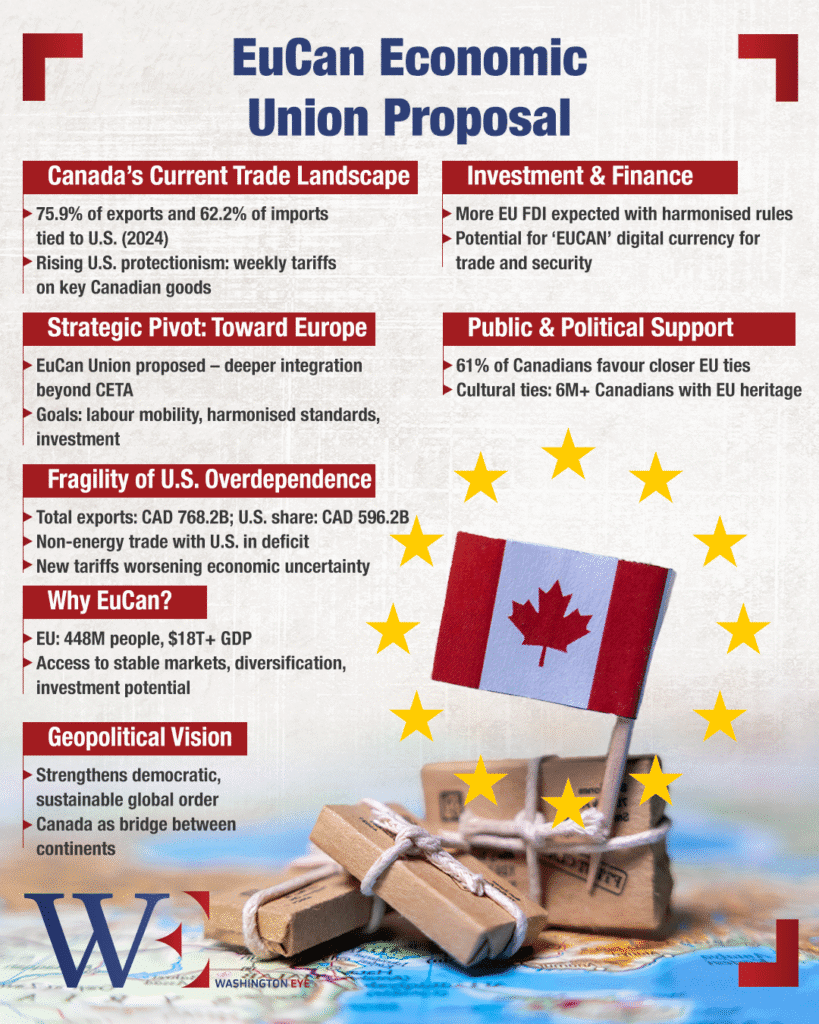Canada is often referred to as the “true north,” yet our economic compass has historically pointed south. The United States has been Canada’s dominant trade partner, accounting for approximately 75.9% of Canada’s total exports and 62.2% of total imports in 2024. However, this heavy reliance has become increasingly fraught with challenges. Recent shifts toward economic protectionism in Washington—highlighted by the imposition of fresh weekly tariffs on Canadian exports such as aluminum, steel, and automotive components—have introduced significant uncertainty. Ottawa now faces a pivotal decision: be submissive and continue deepening ties with an unpredictable partner or diversify towards more stable and varied economic relationships.
A Strategic Pivot: Eastward and Westward
The time has come for Canada to seriously consider establishing a Europe-Canada Economic Union (EuCan Union)—a bold initiative that would transcend the Comprehensive Economic and Trade Agreement (CETA). This union would aim to eliminate restrictions not only on goods and services but also on labor mobility, harmonize investment protocols, and foster deeper alignment between two of the world’s most advanced economic areas. Such a zone would not merely serve as a hedge against American volatility; it could lay the foundation for Canada’s next era of growth.
The Fragility of Overdependence
Canada’s merchandise exports in 2024 totaled approximately CAD 768.2 billion (USD 539.3 billion | EUR 518.8 billion), reflecting a modest 1.0% increase from the previous year. Exports to the United States amounted to CAD 596.2 billion (USD 418.7 billion | EUR 402.5 billion), accounting for about 75.9% of Canada’s total exports. While this indicates continued trade resilience, the performance was heavily driven by energy products, which were key contributors to the trade surplus. Excluding energy exports, Canada’s net trade position with the U.S. shifts into deficit, signaling underlying vulnerabilities in sectors such as manufacturing. This includes ongoing weakness in categories like steel and automotive parts. Additionally, the reintroduction of tariffs on goods crossing the U.S.-Canada border has added to economic uncertainty, further impacting the performance of non-energy exports.
Regarding Foreign Direct Investment (FDI) into Canada, in 2024, Canada continued to see FDI growth, with inflows reaching USD 28.2 billion in the first half, compared to USD 25.5 billion in the same period of 2023. This increase reflects Canada’s strong economic performance, with employment growth leading the G7. However, the Bank of Canada has cited “policy-driven uncertainty in North American trade” as a contributing factor to economic concerns and fragility. This uncertainty, stemming from potential and actual tariffs, could have influenced the pace of FDI during specific periods, even if the annual figure showed an increase. This exposure is not a one-off; it is symptomatic of a broader structural fragility—one that demands proactive strategic correction.
EuCan: Building Beyond CETA
CETA, provisionally in force since 2017, removed nearly 98% of tariffs between Canada and the EU. It was a significant step but stops short of the economic depth required to future-proof Canada’s economy. The proposed EuCan framework envisions a more robust transatlantic economic union, modeled loosely on the European Economic Area (EEA), enabling:
- Seamless labor mobility for professionals, entrepreneurs, and skilled workers.
- Standardized regulatory frameworks, especially in financial services, digital trade, and environmental standards.
- Streamlined capital flows and investment protections, making cross-border expansion between Canada and the EU both easier and safer.
The institutional groundwork for such model already exists. Programs such as Canada-EU Youth Mobility Agreements demonstrate demand for bi-directional labor exchange between citizens of Canada and many European countries. However, these programs remain limited in scope—often constrained by quotas, duration, age, and bureaucratic barriers. EuCan would aim to eliminate such frictions, creating a true transatlantic labor market that is fluid, competitive, and flexible.
Strategic Economic Gains for Canada
1. Export Diversification and Market Stability
A unified economic space with the EU—home to 448 million consumers and a collective GDP of over $18 trillion—would allow Canada to diversify demand for its goods and services. Access to stable European demand reduces overexposure to U.S. economic fluctuations.
2. Addressing Labor Shortages Across Key Sectors
Canada faces demographic pressures, with nearly one in five Canadians aged 65 or older and projected labor shortfalls in various sectors. EuCan could offer critical relief:
- Healthcare: Projected shortages of over 30,000 nurses and physicians by 2030.
- Skilled Trades and Manufacturing: Over 700,000 workers needed in construction and manufacturing by the decade’s end.
- Technology and AI: An estimated 250,000 tech roles may go unfilled by 2026.
Labor mobility from the EU could help fill these voids efficiently.
3. Foreign Direct Investment and Capital Deepening
An economic union would likely boost FDI from Europe—already Canada’s second-largest source of foreign capital. Removal of investment frictions, harmonized corporate governance rules, and mutual recognition of standards could spark a new wave of European investment in Canadian infrastructure, green energy, and digital services.
Financial markets would also benefit. Coordinated capital rules and digital currency frameworks could pave the way for a transatlantic investment corridor, lowering transaction costs and encouraging scale.
Digital Currency Integration: A Bold Frontier
While politically sensitive, a shared digital transaction system or stablecoin—the “EUCAN”—could transform the economic landscape. Designed for cross-border trade settlements and backed by the Bank of Canada and the European Central Bank, this digital unit of account could streamline payments, reduce currency conversion costs, and enhance financial security. With blockchain-backed transparency and smart contract integration, such a mechanism would make the EuCan economic space one of the most advanced and secure financial ecosystems in the world.
A Political Willingness for Change
Polls show growing public support for diversification beyond the United States. According to a 2024 Ipsos survey, 61% of Canadians favor closer economic ties with the European Union, especially in light of growing trade tensions and diplomatic unpredictability with Washington. Political leaders in Canada and Europe have also expressed openness to deeper partnerships, particularly in green energy, digital transformation, and defense cooperation.
Canada’s European diaspora—over 6 million citizens of partial or full European descent—could serve as a strong sociocultural bridge. Cities like Montreal, Toronto, and Vancouver are already home to vibrant French, Italian, Polish, Greek, and German communities with deep transatlantic connections. These networks offer a human infrastructure that could facilitate everything from business ventures to educational exchanges.
The Geopolitical Case for EuCan
In a time of geopolitical fragmentation, an integrated Canada-EU economic space would send a powerful message. It would demonstrate that like-minded democracies can still work together to build resilient, equitable, and sustainable systems—beyond the sphere of one country’s dominance and economic gravity. It would solidify Canada’s global position not as a peripheral player on the edge of American influence, but as a bridge between continents and a proactive shaper of the 21st-century order.
Conclusion: The Next Great Canadian Project
Confederation. Medicare. The Charter. Each represented a leap forward in Canada’s national story. A EuCan Economic Union could be our next transformative project—one rooted not in nostalgia or nationalism, but in strategic realism, economic resilience, and global ambition.
Canada has the legal frameworks, political relationships, human capital, and diplomatic credibility to lead this initiative. What remains is the political courage to act. By reaching across the Atlantic, Canada can move from economic dependency to economic sovereignty—reclaiming its place as a global standard-setter, not a bystander.
The future is not south. It is forward.




















